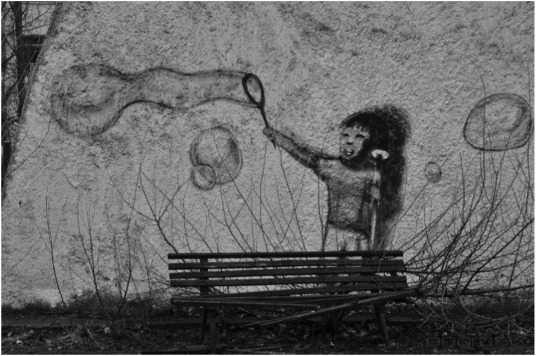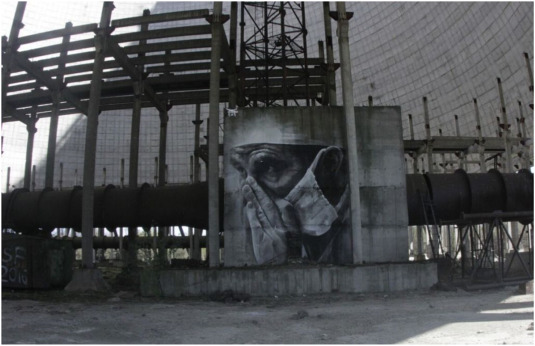
This paper aims to extend dark tourism scholarship concerned with existential aspects of the human nature and the power of ‘dark places’ to provoke our thinking about the meaning and purpose of human existence. Our main focus is on the artistic expressions in the form of murals that have emerged in the years following the nuclear disaster in Chernobyl. We question the significance and meanings they have for the Chernobyl Exclusion Zone, in the context of tourists’ perceptions and, more generally, in the context of our being in the world. To that end, we deconstruct the tourist experience of dark sites through knitting together dark tourism, existentialism and street art.
Recently, dark tourism researchers have begun to interrogate dark tourism experiences and to move away from definitional and exploratory studies to develop deeper understanding of the subjective experiences of tourists. Research into the existential aspects of dark tourism is a relatively new development, as the field evolves from necessary early descriptive and exploratory approaches, along with the ‘emotional turn’. Emotional responses in dark destinations prompted by experiences of mortality salience or ontological insecurity, phenomena that cause individuals to reflect on their relationship to their own death, can be particularly profound and are an emerging area of dark tourism research, to which this study aims to contribute.
In this research, we aim to extend the dark tourism scholarship through exploring the power of murals as artistic expressions to provoke our thinking beyond what is seen and probe deeper into what is experienced and imagined. The interpretation of murals is therefore not considered through an evaluation of their aesthetic merits, but instead with their observer’s ‘emotional and affective investment’ and reflection on the experiences constructed through their lived interactions with them. Mirroring the interpretation of subjective tourism experiences, the interpretation of art is unique in its own right; what is felt and perceived cannot be replicated and the emotion that it stirs up is highly individualised.
We adopted photo elicitation as a visual method hitherto not utilised within dark tourism research. To date however, photo elicitation has mostly focused on the interpretation of still photographs and other visual material, marginalising more creative and participatory methods which can bring richer insights into the experience of those who produce them. This prompted us to include participant-generated data in the interview process, giving attention to photographs of the murals that the participant either created or selected. Instead of being a research subject, the participant themselves generated visual data while exerting greater control over the research process.

In viewing street art as art and (photos of) murals as text, we aimed to deconstruct the tourist encounter with and experience of the Chernobyl Exclusion Zone. Moving beyond the realms of representation we accessed non-representational aspects of the tourist encounter with murals, and probed into the embodied, sensual and emotional experiences of one tourist, William. Here, we discuss how the murals that the participant selected for discussion were given meanings through his own, unique interpretation of art, which provoked deep, existential thinking of meaningfulness and meaninglessness of human life.
Street art, like all art, has the immense power to provoke a myriad of feelings, emotions and states in the viewer. By way of example, in the iconic Munch’s painting, with which the participant compared some murals, the world is depicted as unstable, threatening and potentially dangerous. The Zone murals stirred up similar feelings in the participant. The ones that made strongest impression on him depict sadness, grief, panic, anger or surprise in the face of nuclear explosion. To him, the murals of screaming people, their silhouettes, and unborn children, reflect our common existence, and at the same time act as a warning of impending dangers. William shared his take on the mural depicting a man in the state of a shock, potentially a scientist, a doctor or even a power plant worker:
The image of ‘experimentation’ and mad scientists, mutants are created both by accident and design. Though, obviously these impressions give way when the true meaning of the figures is known, though, it is still linked in so far as ‘mad scientists’ are concerned. This accident was, after all, created by the mad experiment that was Soviet Russia. An experiment that had a multitude of ill effects, this one in particular, Chernobyl, contributed majorly to the destruction of the ‘lab’ itself.
Through his interaction with the murals, William experienced a symbolic encounter with horror, pain and death. In depicting panic and horror, the murals not only truthfully express collective feelings about the meaning of life and closeness of death during the Cold War, but also act as a warning for the present.
William opined that people are trying to find a place in the totally unnatural environment of the modern world. As he explained, “we have comfort, jobs, bills to pay, houses, politics all these things, basically irrelevant when you scratch below the surface”, directly addressing the issue of existential authenticity. Humanity might therefore need to rethink our ‘mission’ on this planet and interrogate the meanings of life and the goals we want to achieve. Is it power, profit and dominance, or happiness, meaningfulness, and belongingness to the natural, as opposed to technologically advanced and digitalised, world?
To cite this work:


No Comments